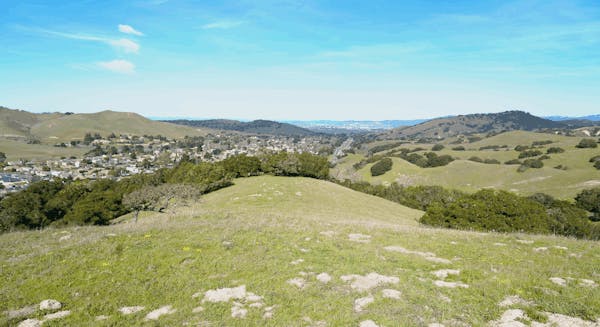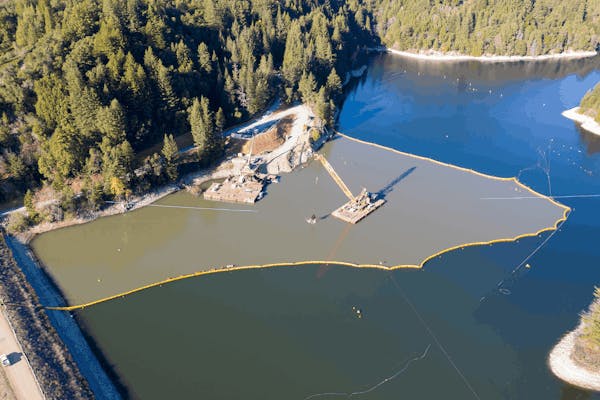Act Now
This giving season presents a unique opportunity to strengthen the place we call home. And this year, there's added reason to act.

Funding Conservation On The Central Coast
This article appeared in the Spring 2025 edition of Santa Cruz Vibes magazine.
Driving north on Highway 1, just past Watsonville, the descent towards Santa Cruz opens to a magnificent view of Monterey Bay lined by the treetops of La Selva Beach. The La Selva Uplands are home to oak groves, grasslands, and over a mile of freshwater streams. They’re also home to the rare and endangered Santa Cruz long-toed salamander. The salamander, and its few existing habitats, are an important link between wetland and forest ecosystems in the region. However, this habitat was once at risk of being sold for residential development.
Now, the 144-acre property named weleeli onyenmak (“Salamander Relatives”) by the Amah Mutsun Tribal Band, is permanently protected thanks to efforts led by the national conservation leader Trust for Public Land (TPL) and local conservation champion, Land Trust Santa Cruz County (LTSCC).

Prioritizing Conservation
But there are thousands of acres like weleeli onyenmak in Santa Cruz County and the larger Central Coast region—surrounding the jewel of the Monterey Bay—that are in danger of development. Over the past three years, TPL, LTSCC, the Amah Mutsun Land Trust and Tribal Band, and other local organizations engaged in a community-centered and data-driven conservation planning process to prioritize the most important and vulnerable lands and waterways in the region. The work spans Santa Cruz, Monterey, and San Benito counties and focuses on building our regional climate resilience, connecting wildlife corridors, and preserving sacred ancestral lands.
According to LTSCC Executive Director Sarah Newkirk, securing these habitats is a race against time, and conservationists need to act quickly. Newkirk explains that the lack of access to quick capital puts organizations like hers at a disadvantage when landowners want to close deals fast.
“There's never any predicting when a project is going to come to us. We do a lot of land prioritization; but prioritization is not the same as coming to an agreement with a landowner, and sometimes you have to do that at the pace of the landowner,” she says.
Community Foundation Santa Cruz County saw an opportunity to help and has partnered with TPL, LTSCC, and the AMLT to establish a rapid funding mechanism to ensure that vital land is protected now and in the future.
Capital with a Purpose
The Central Coast Climate and Conservation Action Fund, also known as the “Strike Fund”, was established by Community Foundation Santa Cruz County in 2023 as a unique, versatile, and fast-acting tool to help acquire and conserve these priority lands before they are sold and developed.
Historically, land trusts — both local and national — have struggled to find financing options to quickly acquire land. Too often, organizations do not know how much financing is available, what interest rates will be like, and how long they have to repay. The Strike Fund solves this problem with transparency, quick action, low interest, and patient loan terms. Additionally, the fund is replenished as payments come in, making new loans possible again to act on prioritized lands as they go on the market.
Susan True, CEO of the Community Foundation says, “Thanks to the generous and forward-thinking donors who created the Strike Fund, we are entering a new era for local conservancy efforts. The Community Foundation is at our best when we support solutions to problems too big to solve alone and the Strike Fund is a perfect example of coming together with new ways to break through old barriers. Up and down the Central Coast, we have the opportunities and expertise to build a more resilient tomorrow, and we are honored to help connect the experts, provide unique access to financial resources, and develop long term resources for our shared future.”

Building Climate Resilience
California is one of the most biodiverse areas in the world, and the Central Coast is where many biomes and wildlife habitats converge. Keeping these connected is crucial to our future climate resilience.
Dr. Chris Wilmers, a professor in the Environmental Studies Department at UC Santa Cruz and head of the Puma Project says that wildlife linkage through habitat connectivity is vital for species like the mountain lion.
“To have healthy, thriving wildlife populations, we need animals and plants to be able to get from one area to another, so that they can exchange genetic material. If they can't do that, they will go extinct,” Wilmers says.

TPL Regional Conservation Director Christy Fischer says that some of the lands the partnership is prioritizing might be small acreage, but huge in their role for habitat connectivity. “Every bit as important—and often far more threatened—are the smaller properties that knit the big chunks together,” Fischer says.
The preservation of these lands is also important to preserve the culture and land stewardship practices of the Amah Mutsun people.
Valentin Lopez, president of the Amah Mutsun Land Trust and tribal chairman, says one of the most important priorities of their tribe is to ensure members take care of Mother Earth and all living things. The Strike Fund is supporting that work.
“The Community Foundation has become a steadfast supporter in our work on traditional stewardship, cultivating healthy and resilient landscapes, and restoring sacredness to the land. We are grateful the Foundation understands this directive from our Creator.”
- Chairman Valentin Lopez

Strike First
Recently, Trust for Public Land requested support from the Strike Fund to help with the acquisition of Ferrini Ranch, a 900-acre area located on the verdant Highway 68 passage between the cities of Salinas and Monterey. The property was preapproved to build nearly 200 luxury homes. With the help of a $10 million Strike Fund loan, TPL was able to secure a deal with the landowners before their 2024 end of year deadline. TPL is now partnering with Big Sur Land Trust to raise the money to pay back the loan, and Big Sur Land Trust will eventually own and steward the land. Once the purchase is finalized, Ferrini Ranch will connect and expand over 20,000 acres of protected natural areas, including Fort Ord National Monument. The land will also be renamed tooromakma hinse nii (pronounced “toe row mock ma hēēn say knee”), which means “bobcats wander here”. It is part of the greater Juristac landscape, a critical cultural and sacred space for the Amah Mutsun.
“Ferrini Ranch provides essential connectivity between the Santa Lucia Mountains and Fort Ord—one of our region’s biodiversity gems, and in so doing enhances the health and adaptability to climate change of our Central Coasts region’s wildlife and plants."
- Dr. Chris Wilmers
Fischer says that closing on the property in such a short time frame would have been impossible without the Strike Fund. “TPL had only months to put this deal together and we couldn’t have done this without the Community Foundation.”

The Future of Conservation
Sarah Newkirk believes the Strike Fund is making what long seemed like a dream into a reality. By listening to its partners in the conservation field, the Foundation’s Strike Fund stepped in to facilitate a fundraising vehicle as rare as the Santa Cruz long-toed salamander.
“The Strike Fund really is the ‘Holy Grail’ in conservation work, and I can't be happier that it exists.”
She encourages potential donors to consider the impact their gift would have on the future of our region. “Any gift to the fund keeps giving. As the loans are repaid, the fund is replenished, and donors’ dollars are used time and again, multiplying the impact of each gift. If there are donors out there that want to maximize their impact on conservation, this is a great way to do it.”
Val Cole, a Donor-Advised Fundholder at the Community Foundation, has the unique perspective of being a donor while also serving on the California Board for TPL.
“I’m grateful that the Community Foundation has started the Strike Fund. It’s one way you can contribute and be a part of something that is really going to last forever. There aren't that many things in the world that are that way.”


